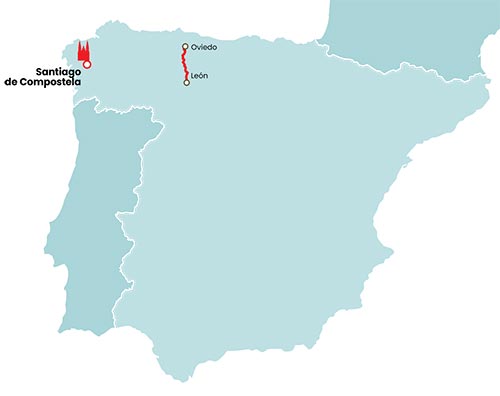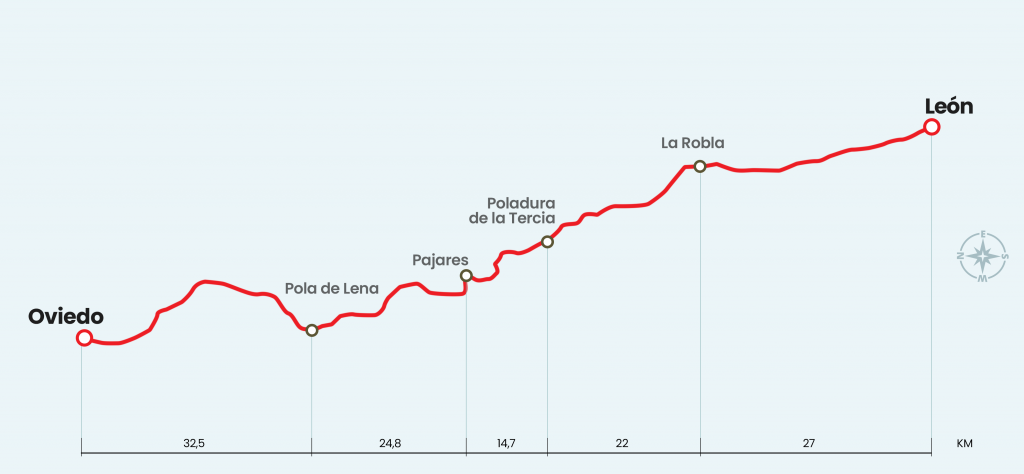Article translated by an automatic translation system. Press here for further information.

San Salvador Road
5
121,8

"Whoever goes to Santiago / And not to San Salvador / Serves the servant / And forgets the Lord". Guided by this stanza, EROSKI CONSUMER has walked the 122 kilometers that separate the Parador Nacional de San Marcos de León and the Cathedral of Oviedo. Based on the information gathered during this pilgrimage and the invaluable collaboration of José Antonio Cuñarro Extac, alias 'Ender' and alma máter of the San Salvador Way, he has developed this practical guide divided into 5 stages, where the entire itinerary is described in detail.
Oviedo was the second most important pilgrimage after Santiago de Compostela
From 1075 on, when the contents of the valuable relics of the ark guarded today in the Santa Chamber of the Cathedral of Oviedo became public, the Asturian capital became the second most important place of pilgrimage after Santiago de Compostela and, from that moment on, moreover, both pilgrimages were linked forever. The inventory of relics, propaganda, legends and word of mouth among pilgrims managed to cross borders and even today these ancient verses resonate among walkers: "Whoever goes to Santiago / And not to San Salvador / Serves the servant / And forgets the Lord".
The Leonese central mountain and the narrow Asturian valleys
Several stages of the San Salvador Way pass entirely or partially through the mountain, with all the advantages and disadvantages that this entails. To the majesty of the landscapes, which have already aroused the fear and curiosity of medieval pilgrims, and the absence of traffic, a more limited number of populations with services are opposed, which offers no problem if we consider some considerations reflected in the guide. In addition, the first three days run at an altitude that varies between the 830 meters of the Leonese capital and the 1,572 meters of the Canto La Tusa, which should be taken into account during the winter months. The Facebook profile of the Camino de San Salvador way, managed by José Antonio Cuñarro, is very active and we recommend visiting it to clear any doubts and to know at every moment the state of the Camino.
Great signalling and sometimes also engineering work
Work always bears fruit, always. The official signs in the province of León, consisting of wooden posts manufactured by Tomero and Romillo, S.L, were carried out in 2008. It was run by the Asociación Cuatro Valles, composed of the municipalities through which the Camino de San Salvador passes in the Leonese part, that is, the municipalities of León, Sariegos, Tablas, La Robla, Pola de Gordón and Villamanín. For its part, the Principality of Asturias took charge of its part from the high of Pajares.
This sign, however, poorly covered mountain areas. No one in that year was able to reach Poladura on the Camino, let alone the Collegiate of Arbas. In the face of this problem, José Antonio Cuñarro asked the Association of the San Salvador Road for permission and in 2009 he began to manufacture metal arrows, which he used and painted in the garage of his friend Juan López, already deceased D.E.P. After placing them he saw that they could be improved, as the animals would bend the arrows. So in 2011, he started designing, again in that garage, the metal shells that we see today. He has also travelled the Camino between León and Oviedo on many occasions, signaling the itinerary with yellow spray cans.
The work went beyond, and will continue as long as pilgrims continue to pass. In January 2012, José Antonio and a woodworking friend placed the wooden pole that indicates the diversion to the hostel of Pajares and San Miguel del Río. Likewise, at the end of October 2012, he and Javi and Jesus successfully built the Pontoon of Romers on a stream that could not be crossed during the growing season. Mention is also worthy of the Cross of San Salvador, a milestone of this Jacobean itinerary situated at 1,452 meters altitude in the upper of Los Romero. It weighs about 250 kilos and was raised by 8 people also in late October 2012.
Network of hostels
Accurate signage attached to a good network of hostels are the two basic ingredients that any pilgrim seeks when choosing one route or another. The Camino between León and Oviedo brings together the two, hence its boom in recent years. In addition to the hostels located in León (Camino Francés) and Oviedo (beginning of the Primitive Way), the Camino de San Salvador has a network of municipal hostels in virtually all the stages, as well as some other private hostel, which speaks well of the boom and popularity of this road among pilgrims. Not to mention other private accommodations such as a hostel or rural house that make this journey perfectly changeable and allow the stages to be divided into very affordable distances. Thus, between León and La Robla is the hostel of Cabanillas; between La Robla and Poladura de la Tercia the hostel of Buiza, etc. This infrastructure helps the pilgrim to travel the route according to his physical capacity, being able to use from four to six and even seven days.
Credential of the Pilgrim and Salvadoran
The San Salvador Way can be travelled with the official credential valid for any Camino de Santiago. This credential is processed and printed the Cathedral of Santiago and sent to the Parishes, Bishopric and Associations of Friends of the Camino de Santiago that request it. In addition, optional, it is possible to make this Road with the credential created and designed ex profeso for this route. It can be achieved in the hostel Fundación Ademar, in the hostel of Las Carbajalas, in the municipal office of information and tourism of León and in the bar Central de Carbajal de la Legua, headquarters of the Asociación Camino de Santiago Ruta de San Salvador.
If the pilgrim who travels, at least, the last 100 kilometers to Santiago, reward him with the Compostela, those who pilgrimage from Leon to Oviedo on the Camino de San Salvador will be rewarded, upon payment, by the Salvadoran. It is an accredited document signed by the Dean of the Cathedral of Oviedo that can be requested both in the cathedral and in the hostel of El Salvador.
Bibliography
A PDF guide to the Camino del Salvador between León and Oviedo, written by José Antonio Cuñarro Extac, which can be downloaded from: https://drive.google.com/file/d/1NH8XQZtdRGd6QvEne610rRwgXJFMgc2U/view?usp=drivesdk
Oviedo and the Treasury of its Cathedral in the Origins of the Camino de Santiago, 2010 edition sponsored by the Fundación María Cristina Masaveu Peterson. This work includes the Proceedings of the Seminar held at the First Conference Cycle of the Camino de Santiago that was organized in Oviedo in April 2008.
The pilgrimages to Santiago de Compostela, written in three volumes by Luis Vázquez de Parga, José María Lacarra and Juan Uría Ríu. A facsimile edited by the Department of Education and Culture of the Government of Navarra was consulted in collaboration with Iberdrola of the edition published in 1948 by the Superior Council of Scientific Research.
The Jacobean Pilgrimages, written in three volumes by Luciano Huidobro and Serna and several collaborators, first published in 1950 and 1951. The edition made by the Provincial Council of Burgos and Iberdrola on the occasion of the Holy Year of 1999 was consulted.